Belize Vacation - May 2007
Jenifer and I recently returned from a 12 day vacation in Belize. We started the vacation at Turneffe Island Lodge which is a private island on the southern tip of the Turneffe Atoll. The lodge is a virtual paradise where you can spend your time scuba diving, fly fishing, snorkeling or just relaxing in a hammock. All food on the island is provided by an awesome kitchen staff that serves up gourmet meals. The meals we had at Turneffe Island Lodge were by far the best we had during our entire stay in Belize.
Some shots of the island.

Our private cabana during our stay.
Jen and I on one of the many well hammocked docks.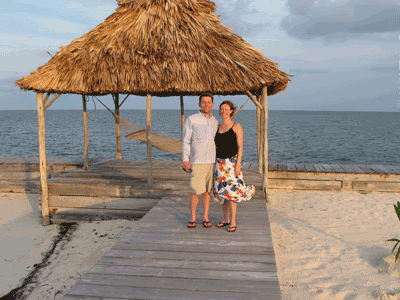
Me enjoying the sunset from the end of a dock.
One of the things that attracted me to this particular lodge was the fact that I could both fly fish and scuba dive. Because the lodge's location on the atoll, I could also take out one of their kayaks and paddle to a nearby flat for some unguided fly fishing and I really wanted to test my ability to site, cast to, and catch bonefish without the aid of a guide.
There is a flat that is accesible from the island by kayak. This flat is pretty large and has an exposed coral reef to the ocean side. The flat extended from the point you can see in the picture below to where I was standing in the photo and then again maybe another half mile toward a fishing and diving site called the elbow. The elbow is an outstanding place to dive and fish. The elbow is a narrow strip of reef about 70 feet underwater that has deep water drop-offs on both sides. Because of the deep water it is a great place to dive and see large pelagic fish. When we dove at the elbow we were treated to the site of a very large school of permit, all in the 20 to 30lb range. You can site fish to these permit from a boat using a sinking line. A number of guests caught big permit at the elbow. I, unfortunately, was not one of them as I spent all of my fly fishing time wading the flats.
This is the flat that you can kayak to from the lodge.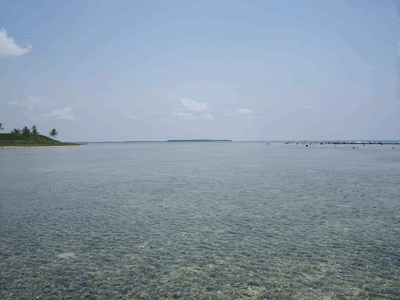
When I first got to the flat I wasn't sure I would see, much less catch, any bonefish. That was until I let out some line and tossed a couple blind casts to refresh my casting skills. As soon as the line landed a bonefish that I did not even see stormed my fly and took off running. Because I didn't know it was there, I did not get a good hookset and he soon came off. Not to worry though, because as soon as I started wading a bit I could see fish everywhere, both in the water moving in decent size schools, and many individual fish tailing. This is my first self-guided bonefish.
My first trip out to this flat resulted in quite a few hookups. My second trip was even better, with a half dozen bones landed and about the same number lost. Landing bones on this flat can be tough because of all of the sharp edged coral, but this also made it exciting as you chased the fish trying to keep the line high and safe from the coral. Here are two more bonefish from this flat.

I also saw one smaller permit here, but he was moving too fast for me to get a cast off. At one point while I was working the edge of the coral reef, I saw so many tails at once that I took a quick picture. Unfortunately, in the picture it is hard to say what is a tail and what is coral.
I spent one afternoon fishing with one of the local Belizean guides that work on the island. We went to a different, significantly larger and somewhat deeper, flat by boat and waded. The fishing on the larger flat was a bit different as most of the bonefish were schooled into large schools that you could see from pretty far as they created the tell-tale "muds" that often betray the bones' location. In the first large school we also noticed one good sized permit hanging out in the middle of the pack. Peremit have a large black tail that makes them easily identifiable in a school of bonefish. Having caught plenty of bonefish already, I really wanted to catch a permit, so I traded my 8wt for a 10wt with a crab pattern and went after the permit. I got off quite a few good casts at the permit, unfortunately I could not get him to eat. But, as everybody would tell me, "that's permit fishing".
The scuba diving at Turneffe was as good as the fly fishing and they run a great scuba operation. Everyday they cleaned our gear after diving and it was organized and on the boat waiting for us the next. Because of the Island's location, most of the diving is a short 10 minute boat ride away. This is true for all the dive sites, save the world famous "Blue Hole" that the lodge dives on Tuesdays. The Blue Hole was everything we hoped it would be.
An aerial of the Blue Hole.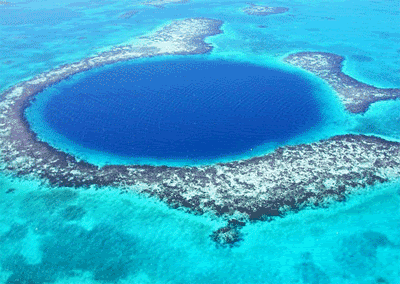
The Blue Hole was formed when the roof of an underwater cave collapsed. The edge of the hole is at about 55 feet deep. You dive the Blue Hole by dropping to the edge, and then dropping to between 120-140 feet and swimming under the ledge into the cave. Once under the ledge you swim through gigantic stalactites and stalagmites. We went down about 140 feet during our dive. If the dive already isn't cool enough, the hole is also home to a large number of reef sharks. The reef sharks hang out toward the center of the hole around 70 feet down. Being the first boat to the hole that day and the first dive group to go down, we did not see the sharks during our rapid descent. However, as you ascend more slowly and pass about 70 feet the sharks see you and begin swimming closer. We had a pack of about a dozen very large reef sharks swim near us and follow us to the surface. Seeing the sharks was very cool.
Because the boat ride to the Blue Hole is about an hour and a half from the lodge, you spend the entire day in the area diving two more sites and having lunch at the Half Moon Caye Bird Sanctuary.
Half Moon Caye.
The island is a bird sanctuary and is an important nesting site for the endangered Red-footed Boobie. You can hike to an observation deck to view the numerous Boobies and Frigate birds that nest in the canopy.
Hiking to the observation deck.
A baby Red-footed Boobie.
The second two dives we did during our trip out to the Blue Hole were no less spectacular than the hole itself. Both were wall dives with numerous coral swim-throughs and incredibly vibrant coral. Unfortunately, we did not have an underwater camera, so I don't have any diving photos to share. On one of the dives we saw some spectacular Eagle Rays and a nice school of permit. On the other dive I swam through a narrow passage and came into an opening where there were about a dozen very large tarpon schooled up. When swiming underwater slowly, you can get incredibly close to tarpon and truly appreciate their size and beauty.
Our second stop in Belize was the laid back and relaxed island of Caye Caulker. From Caye Caulker you can dive, fly fish, swim, and snorkel. The island also has quite a few nice restaurants, although the food in Belize is by no means cheap.
Main Stree, Caye Caulker.
Caye Caulker is very laid back and they like to remind you that drinking is fun.
And that it is better not to litter.
Having been unsuccessful in catching a permit at Turneffe I wanted to give it one more try. Furtunately, I stumbled upon the Anglers Abroad Fly Shop on the north end of the island. The owner of the fly shop was incredibly helpful and forthcoming with local fishing information. He told me where I could go wade for bonefish from the island (which I did and caught even more bones) and also hooked me up with a local guide that specialized in permit. We spent a guided half day looking for permit and the guide definitely delivered the fish, I unfortunately did not deliver the hookups. Permit in deep water are hard to see and you really only have one shot at getting a crab in front of them before they spook. I had problems picking them out until they were too close. We had a lot of the age-old guide-client "See them, there RIGHT THERE!" To my response of "WHERE?" type conversations. This is me out looking for permit.
I did have a few permit follow my fly, but never did get one to eat. Jen, however, hooked up with a nice permit using a live crab and a spinning rod. The permit, unfortunatley, broke off.
We also dove at the Hol Chan Marine preserve which inlcuded a stop at Shark-Ray Alley to swim with, of course, sharks and rays. They were there.
After spending a week out on the islands, we headed inland to see the jungle. We stayed at the Black Rock Lodge which is outside of San Ignacio on the Macal River. The lodge was already an incredible place to stay, but had also recently come under new ownership. The new owner, an friendly, birding fanatic who has nearly a decade of experience operating eco-lodges in Mexico, will no doubt make this already amazing place even more spectacular. The lodge provides great food and a friendly and knowledgable staff that caters to your every need and organizes any activities you would like to do. I personally liked Black Rock's location, it being the most upstream of the lodges on the Macal where the water is cleaner and swifter making the swiming and tubing more inviting than the downstream lodges (which are also downstream of cattle land where cattle freely wade into the river).
Jen and I chose to do the Actun Tunichil Mucnal cave tour. This cave is a Mayan site set deep in the jungle that was first discovered and published in 1989 and opened to the public in 1998. The cave is an important Mayan site where both human sacrifice and blood letting rituals were performed in the period between 1 and 1000AD. There are over 400 hundred ceramic pots in the cave and 14 skeletal remains of human sacrifice victims(7 adults and 7 children under the age of 5). The cave tour is a no-nonsence tour that involves a 3 mile hike through dense jungle (our group spotted multiple snakes) with 3 river crossings. Once at the entrance of the cave, you don a helmet and headlamp and venture about a half mile deep along a river and then up into the main archeological chamber.
The picture below is the entrance to the cave. You have to swim across a chilly pool and then most of the trek into the cave involves wading, swimming, climbing and crawling through narrow passages.
Me with my spelunking gear on.
Your guide will bring your camera into the cave in a dry bag and give it to you after you climb into the main archeological chamber that is above the water line. Once you scale into the chamber, you remove your shoes and put on a pair of socks so not to damage the cave floor with body oils which apparently stop cave formation. Once into the main chamber you are surrounded by Mayan artifacts. This is a cluster of Mayan pottery.
A stalagmite.
More pottery.
A pot with a cool monkey symbol. Apparently this same symbol is also found on ceramic pots at sites located far from the cave.
This is the first evidence of human sacrifice you come across.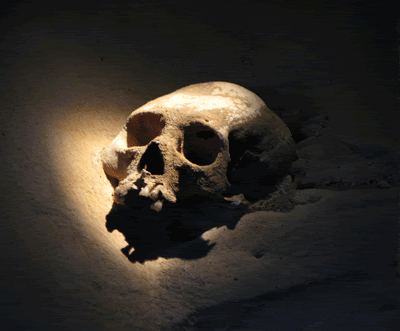
Once you reach the very back of the main chamber you climb an attached aluminum ladder into a smaller chamber where there are two more skeletons. This is the first skeleton you come to. Apparently this sacrifice was not a voluntary sacrifice and the victim was killed while kneeling facing the wall with their hands tied behind his back.
The final skeleton in the cave is the "Crystal Maiden" and is an almost perfectly preserved, complete, skeleton of a woman of about 18 years in age.
The cave tour was definitely one of the highlites of our trip to Belize and quite an experience.
From Black Rock we also canoed down the Macal river through the jungle.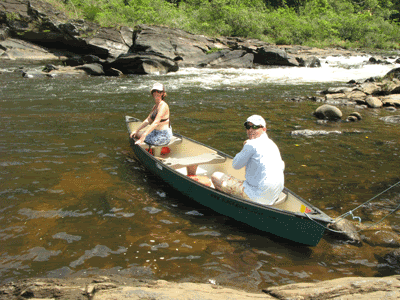
On the canoe trip we spotted countless birds, a large eagle of some sort, numerous iguanas and a large pack of butterflies that had congregated on the shore of the river.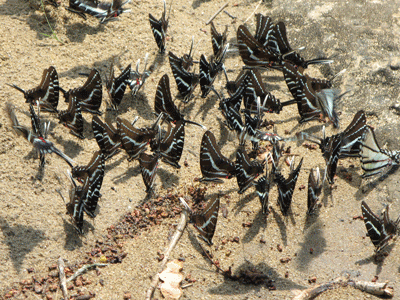
The Macal River by canoe.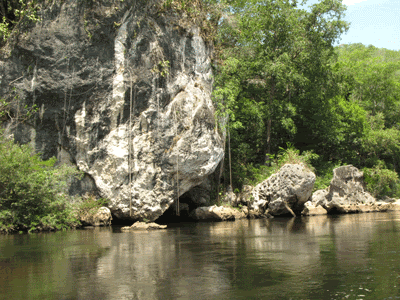
The last site we visited was the Mayan site of Xunantunich which was only a short drive from the lodge.
All in all, we had a great vacation in Belize with superb fly fishing, outstanding diving and exciting tours of ancient Mayan sites--a great way to spend some time out of the office.
